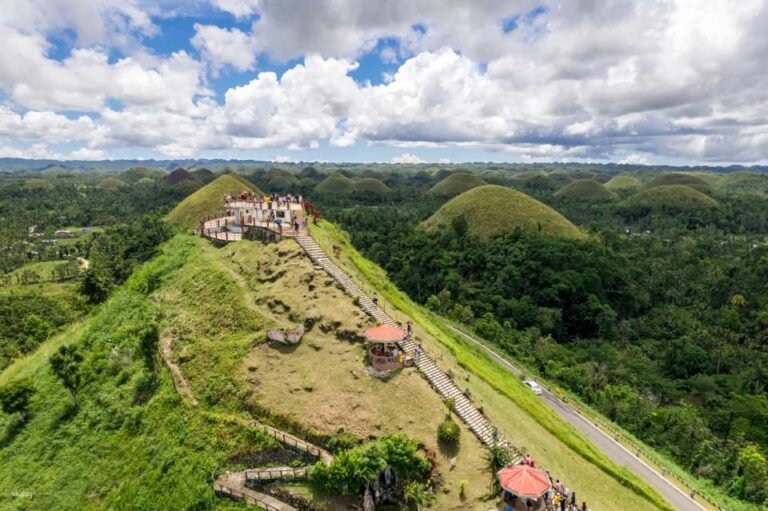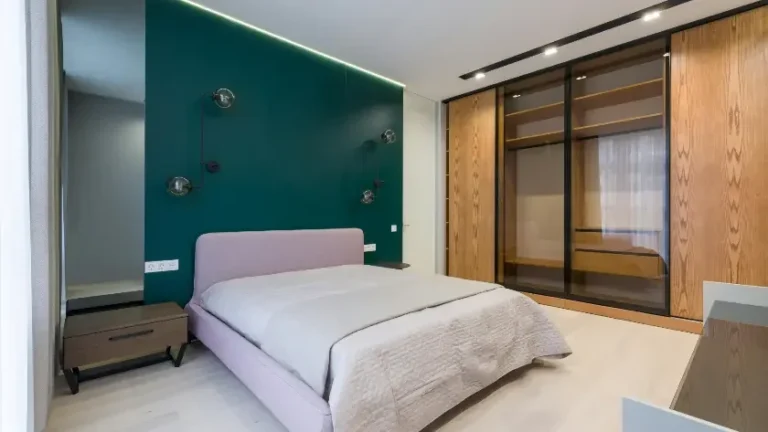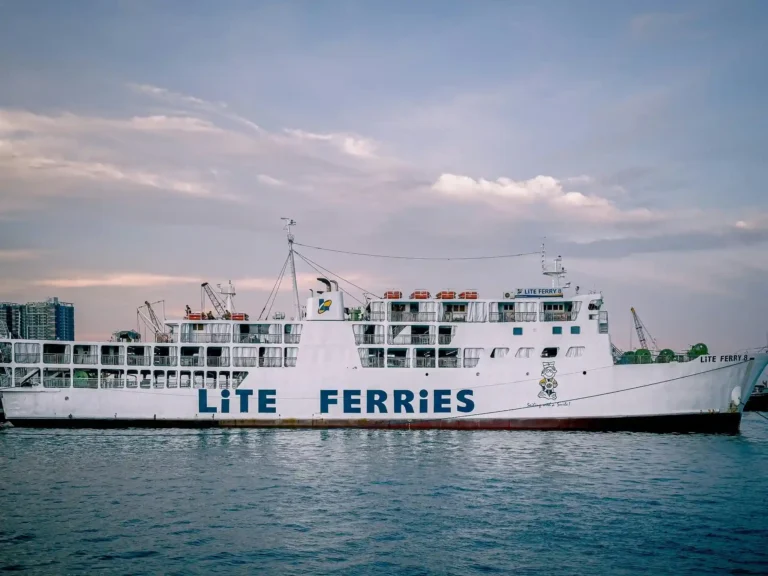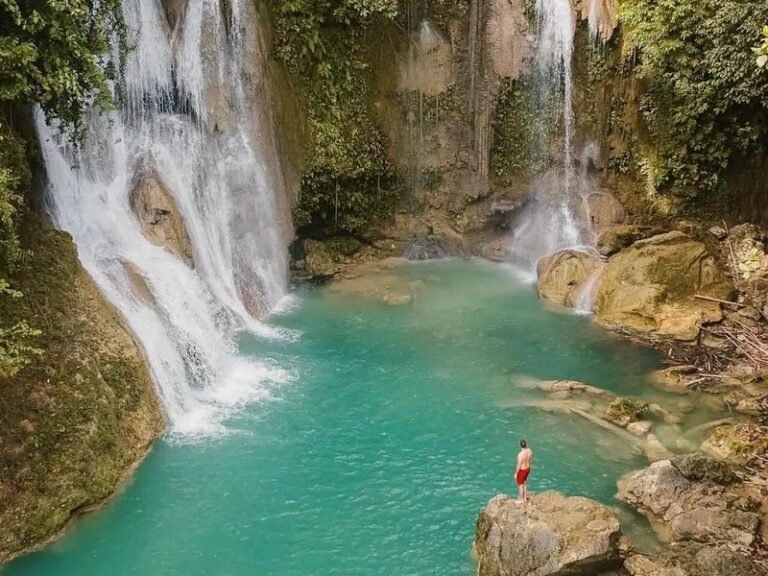Drive Through the Enchanted Bilar Man-Made Forest: A Complete Travel Guide
A Tunnel of Trees in the Heart of Bohol
Imagine driving through a natural cathedral where towering mahogany trees form a perfect green tunnel overhead. Sunlight filters through the dense canopy, creating dancing shadows on the asphalt road below. This magical scene isn’t from a fairy tale—it’s the famous Bilar Man-Made Forest, one of Bohol’s most photographed and enchanting destinations.
Located along the scenic route between Loboc and Bilar towns, this remarkable forest serves as a gateway to the famous Chocolate Hills. But don’t let the word “man-made” fool you into thinking it’s artificial. This living tunnel of trees has become a symbol of successful reforestation and offers visitors a chance to experience nature’s beauty enhanced by human dedication.
What is the Bilar Man-Made Forest?
The Bilar Man-Made Forest is a testament to environmental restoration that began in the 1960s. Local students, volunteers, and government workers planted thousands of mahogany saplings (Swietenia macrophylla) across approximately two kilometers of the Loay-Bilar road. Their goal was simple but important: combat soil erosion and restore the area’s green cover after years of deforestation.
What makes this forest feel truly “enchanted” is its remarkable uniformity. The mahogany trees grow in perfect rows, creating natural symmetry that’s rare in wild forests. As you drive or walk through, the temperature drops noticeably—sometimes by 5-10 degrees Celsius—thanks to the dense canopy that blocks direct sunlight. The filtered light creates an almost mystical atmosphere that photographers and nature lovers find irresistible.
The forest spans roughly two kilometers, making it perfect for a scenic drive, motorcycle ride, or leisurely walk. Unlike natural forests with mixed tree species of different heights and ages, the Bilar Forest’s uniform mahogany trees create cathedral-like arches that seem to stretch endlessly ahead.
The Science Behind the Silent Beauty
While the Bilar Man-Made Forest is undeniably beautiful, it’s important to understand its ecological characteristics. The mahogany trees, though stunning, are non-native to the Philippines. These tropical hardwood trees originally come from Central and South America and were introduced to Southeast Asia for timber production and reforestation projects.
Mahogany trees have a unique characteristic: they produce acidic soil conditions that discourage the growth of native undergrowth. This is why the forest floor appears relatively clear compared to natural Philippine forests. The lack of diverse plant life also means fewer insects, birds, and small mammals call this forest home compared to Bohol’s native forests.
For a stark contrast, visit the nearby Rajah Sikatuna Protected Landscape, where you’ll find Bohol’s original dipterocarp forests teeming with native wildlife including the endangered Philippine tarsier, flying lemurs, and over 200 bird species. The difference highlights the importance of preserving native ecosystems alongside appreciating reforestation efforts like the Bilar Forest.
Scientists classify this type of ecosystem as a “monoculture plantation”—dominated by a single tree species. While it serves important functions like preventing soil erosion and providing some carbon sequestration, it doesn’t support the biodiversity that natural forests provide.
Hidden Gem: The Forest Park and Walking Trails
Most tourists experience the Bilar Man-Made Forest as a quick photo stop during countryside tours. However, hidden within the forest is the Bilar Ecopark, a well-maintained facility that offers a deeper forest experience.
The ecopark features several walking trails that wind through different sections of the forest. Educational panels along the trails provide information about reforestation, local ecology, and conservation efforts. Tree identification markers help visitors learn about different plant species, including some native varieties that have been introduced to diversify the ecosystem.
The park includes shaded rest areas with benches, making it perfect for families with children or older travelers who want to enjoy the forest at a relaxed pace. Some trails lead to small viewpoints where you can see the forest canopy from above and appreciate the scale of this reforestation project.
Why do many travelers miss this gem? Most countryside tours allow only 15-20 minutes for photos at the roadside, and many visitors don’t know about the ecopark entrance. The lack of prominent signage means that even those who notice the entrance often assume it requires a separate fee or guide.
Pro tip: The ecopark entrance is free, and you can explore the trails independently. Budget at least 45 minutes to an hour if you want to walk the main trail and enjoy the peaceful forest atmosphere.
How to Get There
The Bilar Man-Made Forest is conveniently located along the main road connecting several of Bohol’s top attractions. From Panglao Island (where most hotels and resorts are located), the drive takes approximately 1.5 hours. From Tagbilaran City, it’s about an hour’s drive through scenic countryside.
The forest is accessible by various transportation options:
Private vehicle or rental car: This gives you the most flexibility to stop and explore at your own pace. Car rentals with drivers are popular among tourists and typically cost 3,000-4,000 pesos per day.
Motorcycle or scooter: A favorite among adventurous travelers, motorcycles allow you to stop easily for photos and feel more connected to the environment. Rental costs range from 400-800 pesos per day.
Countryside tour van: Most organized tours include the forest as part of a full-day itinerary visiting the Chocolate Hills, Loboc River, and Tarsier Sanctuary. While convenient, these tours usually allow limited time for exploration.
The forest is included in virtually every Bohol countryside tour package, making it one of the most accessible attractions on the island. The road is well-maintained and suitable for all types of vehicles.
Best Time to Visit
Timing can make a huge difference in your Bilar Forest experience. The best times to visit are:
Early morning (7-9 AM): The forest is peaceful with minimal traffic. Morning light filtering through the canopy creates beautiful photography conditions. The air is coolest during these hours, making walking more comfortable.
Late afternoon (4-5 PM): Another excellent time for photography as the angled sunlight creates dramatic shadows and golden highlights. The temperature is comfortable, and you’ll avoid the midday heat.
Avoid midday (11 AM-2 PM): While the forest canopy provides shade, the contrast between bright patches and shadows can make photography challenging. This is also when most tour groups arrive, making the road busier.
Weekdays vs. weekends: If possible, visit on weekdays when there’s less tourist traffic and more opportunities for quiet contemplation. Weekend visits often coincide with local tour groups and family outings.
The dry season (December to May) offers the most predictable weather, but the forest is beautiful year-round. During the rainy season (June to November), the foliage is particularly lush, though you should be prepared for possible afternoon showers.
Photography Tips and Instagram-Worthy Spots
The Bilar Man-Made Forest offers some of the most striking natural photography opportunities in Bohol. Here are expert tips for capturing the perfect shot:
The classic tunnel shot: Stand in the center of the road with the mahogany trees forming a natural arch overhead. Use a wide-angle lens or your phone’s panorama function to capture the full effect. Always have someone watching for approaching vehicles—safety first!
Lighting considerations: Avoid harsh midday sun which creates overexposed spots and deep shadows. The soft, filtered light of early morning or late afternoon provides even illumination perfect for photos.
Camera settings: If using a DSLR or mirrorless camera, try a polarizing filter to reduce glare and enhance the green colors of the foliage. For phone photography, HDR mode can help balance the bright and dark areas.
Composition ideas: Besides the classic road shot, try photographing the vertical lines of the tree trunks, the patterns of light and shadow on the forest floor, or close-up details of the mahogany bark and leaves.
Safety reminder: Never stop in the middle of the road for extended periods. Pull completely to the side, and have someone act as a spotter for approaching traffic.
8. Nearby Attractions to Combine
The Bilar Man-Made Forest’s location makes it perfect for combining with other top Bohol attractions:
Loboc River Cruise (30 minutes away): Experience a peaceful boat ride along Bohol’s most famous river while enjoying a traditional Filipino buffet lunch. The river cruise showcases Bohol’s natural beauty and local culture.
Tarsier Sanctuary (15 minutes away): Meet the world’s smallest primate at the Philippine Tarsier Sanctuary. These nocturnal creatures with huge eyes are endemic to the Philippines and critically endangered.
Chocolate Hills (45 minutes away): Bohol’s most famous landmark features over 1,200 cone-shaped hills that turn chocolate brown during the dry season. The main viewing deck offers panoramic views of this geological wonder.
Butterfly Conservation Center: Learn about Bohol’s native butterfly species and their conservation. The center houses dozens of colorful butterfly species in a natural garden setting.
Python and Wildlife Sanctuary: See native and non-native reptiles, including large pythons, in a controlled environment that supports conservation education.
Most travelers combine 3-4 of these attractions in a single day trip, with the Bilar Forest serving as a scenic transition between destinations.
Responsible Tourism and Travel Tips
As with any natural destination, responsible tourism helps preserve the Bilar Forest for future generations:
Leave no trace: Pack out all trash and avoid leaving any food scraps that might attract animals or insects. The forest’s beauty depends on keeping it clean.
Respect the trees: Don’t climb the mahogany trees or break branches for souvenirs. These trees took decades to grow and form the forest we see today.
Traffic safety: When stopping for photos, pull completely off the road. The narrow highway can be dangerous, especially around blind curves.
Support local conservation: Consider visiting the Bilar Ecopark and supporting local guides who provide educational information about reforestation and conservation.
Noise levels: Keep voices low and avoid playing loud music. The forest’s peaceful atmosphere is part of its appeal, and loud noises can disturb any wildlife that does live in the area.
Photography etiquette: Be patient and courteous when taking photos, especially if other visitors are waiting for their turn at popular spots.
Scientific and Educational Value
Beyond its beauty, the Bilar Man-Made Forest offers valuable lessons about reforestation, environmental management, and the relationship between humans and nature. The project demonstrates both the possibilities and limitations of human intervention in natural systems.
Reforestation success: The forest shows how dedicated human effort can transform degraded land into a thriving ecosystem. From bare, eroded hillsides in the 1960s, the area now supports a dense forest canopy.
Ecological trade-offs: The choice of non-native mahogany trees achieved the primary goal of erosion control but created a monoculture with limited biodiversity. This highlights the complexity of environmental restoration projects.
Carbon sequestration: The mature mahogany trees now absorb significant amounts of carbon dioxide from the atmosphere, contributing to climate change mitigation efforts.
Educational opportunity: The forest serves as an outdoor classroom where visitors can learn about different approaches to environmental conservation and the importance of both preserving natural forests and supporting reforestation projects.
For students and educators, the Bilar Forest provides concrete examples of ecological concepts like succession, monoculture vs. biodiversity, and human impact on ecosystems.
More Than Just a Photo Stop
The Bilar Man-Made Forest represents more than just a scenic drive or Instagram backdrop—it’s a living testament to environmental restoration and human dedication to healing damaged landscapes. While it may lack the biodiversity of natural forests, it serves crucial functions in preventing erosion, providing habitat for some species, and demonstrating successful reforestation techniques.
Take time to appreciate not just the forest’s photogenic beauty, but also its deeper story. Walk the trails in the Bilar Ecopark, read the educational materials, and reflect on the relationship between conservation and human needs. Consider how this reforestation project connects to broader environmental challenges facing the Philippines and the world.
Don’t just pass through the Bilar Man-Made Forest—pause, explore, and let this tunnel of trees tell you its quiet but important story. Whether you’re interested in photography, environmental science, or simply experiencing natural beauty, the forest offers something meaningful for every type of traveler.
The enchanted feeling you experience driving through these mahogany arches isn’t just about the filtered sunlight and cool air—it’s about witnessing what’s possible when communities work together to restore the natural world.
Ready to explore Bohol’s natural wonders? Visit our Bohol and Cebu travel websites for comprehensive information about tours, hotels, and travel tips. Book your countryside tour packages, vehicle rentals, and accommodation to make the most of your Philippine adventure. From the mystical Bilar Forest to the iconic Chocolate Hills, let us help you discover the natural treasures of the Visayas region.







